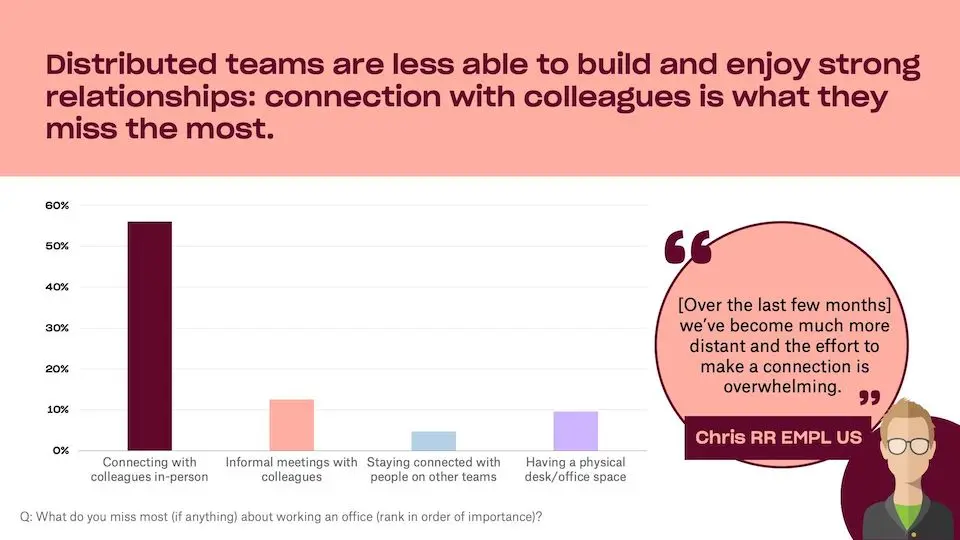
We may be more productive, but remote work is still missing this
Published on August 10, 2020
According to a recent Cushman Wakefield survey of 50,000 workers, 75% say they can effectively focus on finishing their tasks while WFH. But after five months of learning how to adapt to distributed work, many sense that productivity might not be the biggest problem to solve.
When offices closed and workers migrated to their homes to set up remote workspaces, some were more prepared than others. Some were early adopters, working for businesses that were intentionally built with the help of tools like Zoom, Slack, Trello, Teams, and Dropbox.
These remote work veterans were already equipped to sail smoothly through the transition. But for those who were learning video conferencing and cloud collaboration tools for the first time, the sudden shift to two-dimensional teamwork probably felt like being dropped into a cold sea and told to swim to shore.
Half a year in, does working from home make you appreciate freedom from the office or make you ache for interacting in person even more?
A new study on emergent trends in remote work
After speaking with our internal team about the ups and downs of WFH life, we wanted hear more from workers in other companies and other industries to learn how they’re adjusting.
As the head of international research at Dropbox, Jen DiZio leads the New Frontiers research team. She partnered with Amanda Gail Miller, Senior Design Researcher on the Enterprise line of business at Dropbox, to conduct research that explores the emergent trends in distributed work and opportunities for product innovation.
Does working from home make you appreciate freedom from the office or ache for interacting in-person?
They surveyed 4,000 people from the US, Canada, Australia, France, UK, Japan, and Singapore in industries ranging from construction, education, engineering and architecture to finance, health care, media, technology and real estate. They also interviewed 36 workers—half from historically remote companies and half from recently remote companies.
Workers were asked a range of questions, including which tools they used to communicate with colleagues before and after COVID, which tools they used for virtual meetings, what challenges they faced moving to remote meetings, how they're trying to build community, and what they miss most about working in the office.
What DiZio and Miller discovered is that although distributed work can boost productivity, people are feeling blocked by the absence of one factor that’s harder to measure: human connection.

“There’s a big misconception that the reason people need to meet in the office is to have these brilliant brainstorm ideas,” says DiZio. “You talk at the water cooler and all of a sudden you decide the project of the year. We think the real value of this connective tissue is that you’re more present, and more in tune with people from other teams.”
DiZio believes these are the moments that forge important relationships between co-workers. Without those connections, people become more siloed in their individual roles.
“We have technology that can help us, but a lot of research shows it still doesn’t replace that physical presence,” she says. “That metaphor of the connective tissue really stood out for us.”
Can technology evolve to fill the gap?
According to the survey DiZio and Miller conducted, 41% of workers feel existing tools fall short of enabling spontaneous synchronous ways of working.

Miller says psychological safety is one of the critical factors for creating the “healthy” connective tissue that improves this kind of collaboration. Without having the opportunity to build mutual trust, it’s harder for teams to feel productive and impactful.
“It’s that unquantifiable building of trust that happens just because you’re vibing with them on a personal level,” DiZio adds. “Inevitably, that leads to more collaboration. The more you build that trust with people, the more you think, ‘This is somebody I want to work with in the future.’”
“We also learned that within a distributed organization, that feeling of trust and safety naturally frays over time,” says Miller. “Historically remote companies compensate for that by regularly scheduling team building off-sites where people can bond and build that muscle.”
Since the pandemic prevents teams from bonding in person, though, new technology will need to be invented to help people bridge the growing feeling of emotional distance.
“One of the questions we isolated in our study was: How might we develop product solutions so distributed teams can bond and build trust while they’re distributed?” says Miller. “This would counteract the fraying process and fill in a huge unmet need for distributed organizations.”
Miller notes that one of the insights that came through clearly in their research is that current solutions are designed around productivity and are more transactional in nature.
“In addition trust and psychological safety, one of the things that human beings need when they’re on a distributed team is context,” says Miller. “Why are they sending this document to me, where is it in the workflow, what do they need done, etc. There are opportunities to build that context into cloud-based digital collaboration tools in a more integrated way. There are also opportunities to build products that enable spontaneous creative work sessions with colleagues.”
Miller says from a product standpoint, companies need to ask two key questions:
- How might we facilitate a continuity of those collaborative relationships in the product?
- How might we design solutions so that team relationships don’t fray like they currently do?
“There’s something very unique about building connections in-person,” she says. “As a thought experiment, a design question might be: How might we build solutions so that teams don’t need to be as dependent on these quarterly in-person events? In that imagined world, their sense of cohesion and collaborative trust is so complete that meeting in-person is unnecessary.”
Enabling spontaneous synchronous collaboration
In the research findings, Miller noticed that one of the things that’s missing is a way for distributed teams to conceptualize and creatively "imaginate" together.
“The current solutions that are available—MURAL, Google slides, Figma—weren’t designed with that need in mind,” she says. “People are looking for solutions that are very fast, lightweight, simple, and intuitive. One of the ideas that we also surfaced was a touch-based team whiteboard for teams to spontaneously collaborate using an iPad.”
One of the insights that came through clearly in their research is that current solutions are designed around productivity.
“Some design teams have been relying heavily on tools like MURAL,” DiZio adds. “What we heard from other people is it tends to be design heavy. It's great for a room of designers to use, but for others types of thinkers, it hasn’t been so successful.”
And though many of us now spend several hours a day in Zoom meetings, DiZio says people often wanted some kind of shared workspace or virtual whiteboard where people could simultaneously scribble down ideas in real time as they used to do on physical whiteboard.
Another idea that arose from the research involved automated calendaring enabled by machine learning. What if you had AI software that noticed when two people were working on similar projects, then it automatically created a meeting for you both to sync up? Or what if your calendar noticed teammates who haven't caught up with in a while and added a spontaneous meeting to their schedules? Another idea that came up was a virtual coffee room where you could just hop in and meet people throughout the day.
“The appeal of AI-enabled calendaring is that people from distributed teams would be able to meet across time-zones and at their convenience and discretion when they want to connect with colleagues,” says Miller. “Of course, there’s a fine line between forcing people to connect ‘because you’re supposed to’ and providing a platform for natural and spontaneous relationships to build.”
"We’re just at the starting point of a lot of amazing technology and evolutions in how we work and what the workplace looks like.”—Amanda Miller
The key will be to bring together people in a way that adds a true sense of personal connection rather than an obligation to “talk shop” as another duty in your role. DiZio says a common complaint surfaced in the findings was that meetings were all about work. And when the feeling of connection get lost, meetings become wearisome.
What can we be doing better?
“One of the things we think we need is a shift in what ‘productivity’ looks like,” says DiZio. “In the US specifically, we have this way of working when we're in the office. You get in at nine, and you leave at 5:00 or 6:00 and you finish your projects—that's our mindset. But if you find that you can complete your work more efficiently outside of the office, why not use that time to contribute to other initiatives, such as ones offered by DEI or other causes that you support? 'Productivity' should be much more than delivering on a product or project, but rather defined in a more holistic way—one which includes contributing to overall organizational health and well-being.”
“The focus of the workplace environment isn’t just about manifesting maximum productivity,” adds Miller. “There are all sorts of interesting ways economists have tried to quantify workplace productivity throughout the 20th century and so much of what organizational psychologists have brought to the table is an understanding of how teams can work together best. That’s been studied extensively in terms of factories and in-person offices, but we’re on a new frontier in terms of fully distributed organizations. We’re just at the starting point of a lot of amazing technology and evolutions in how we work and what the workplace looks like.”



